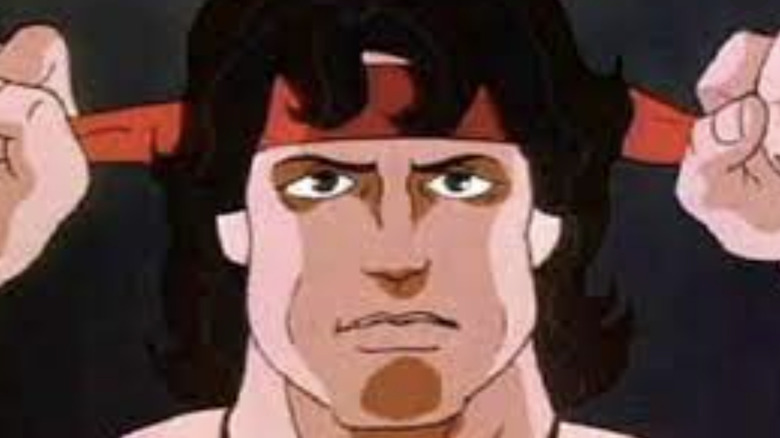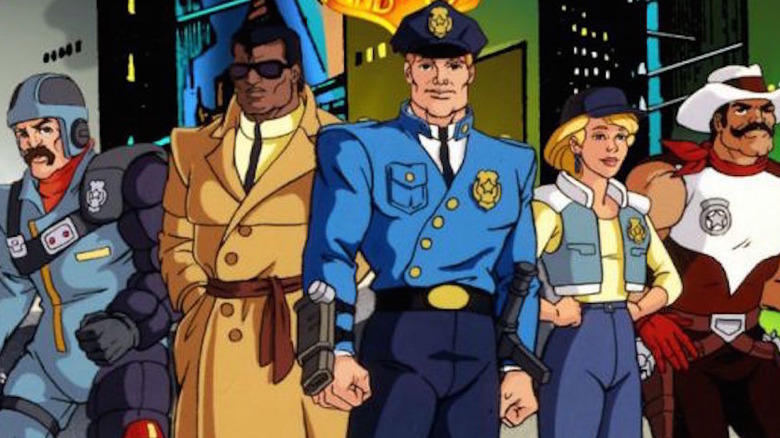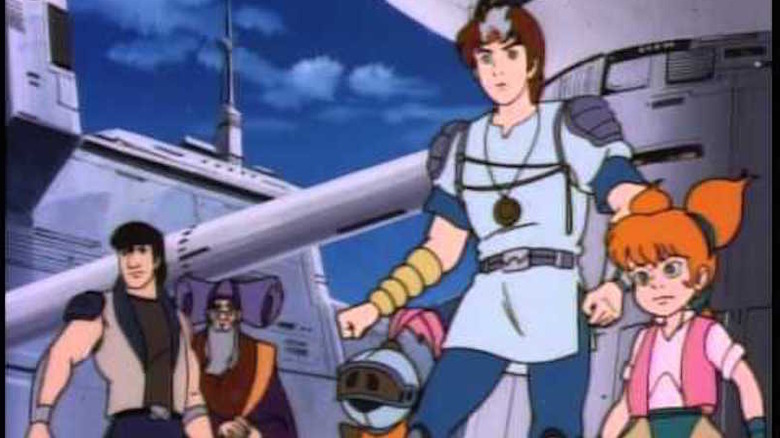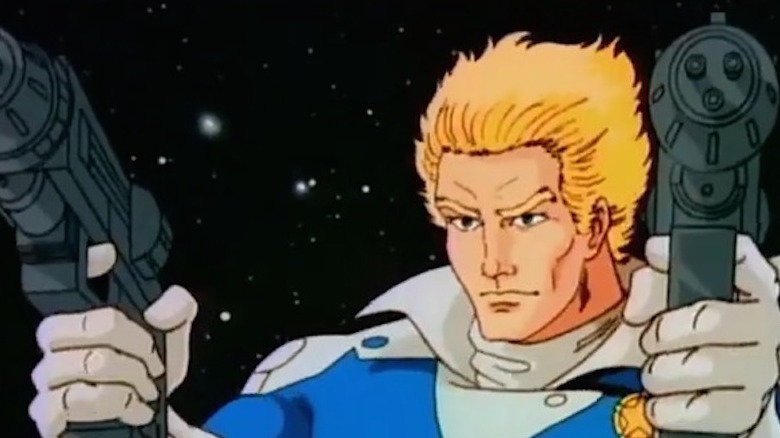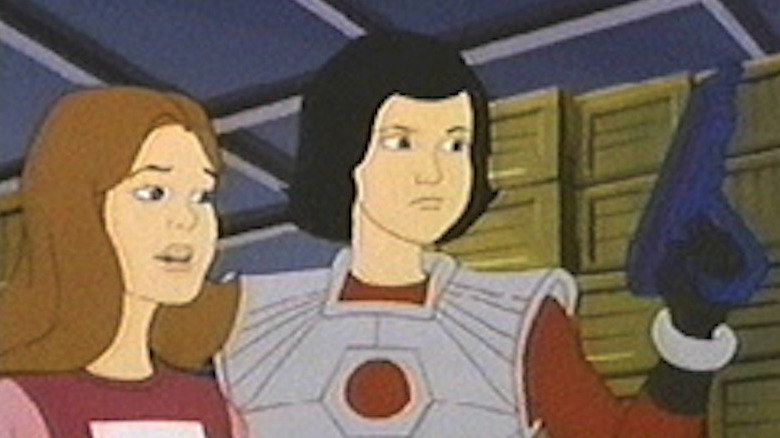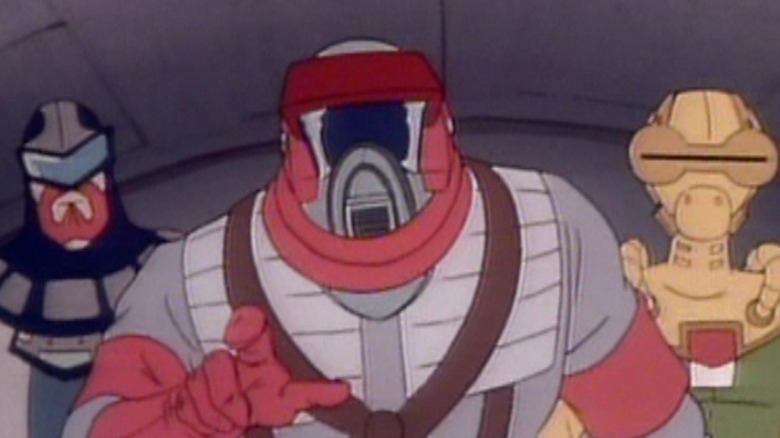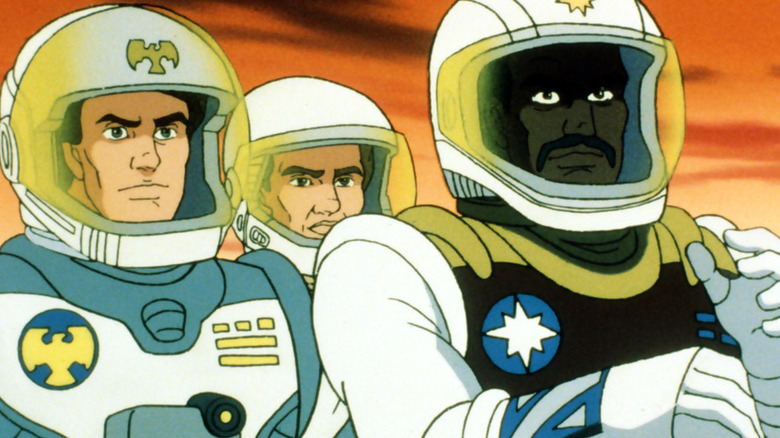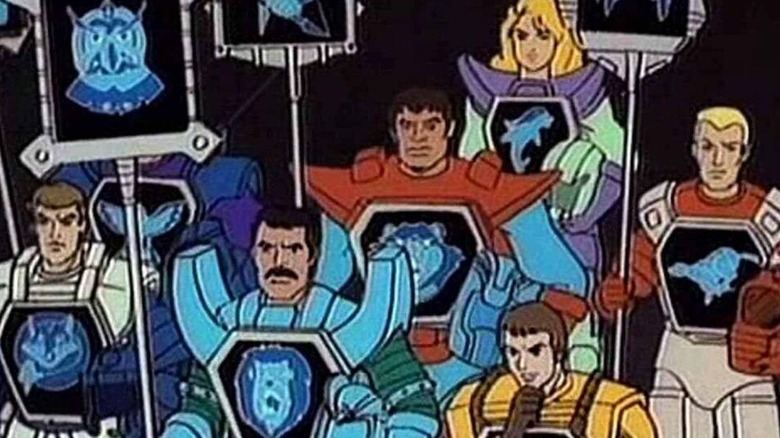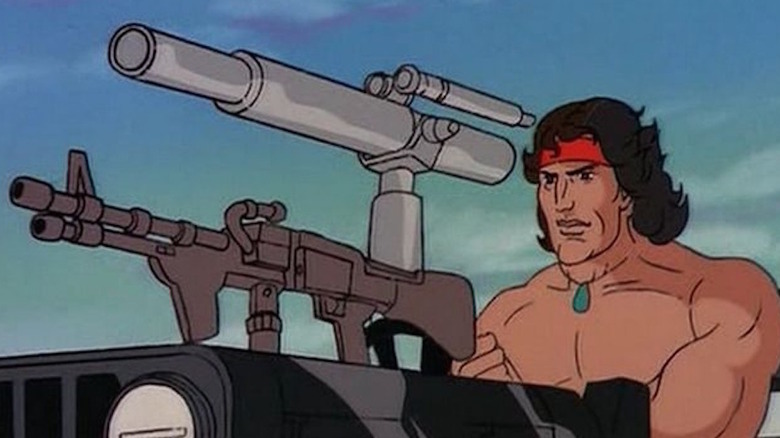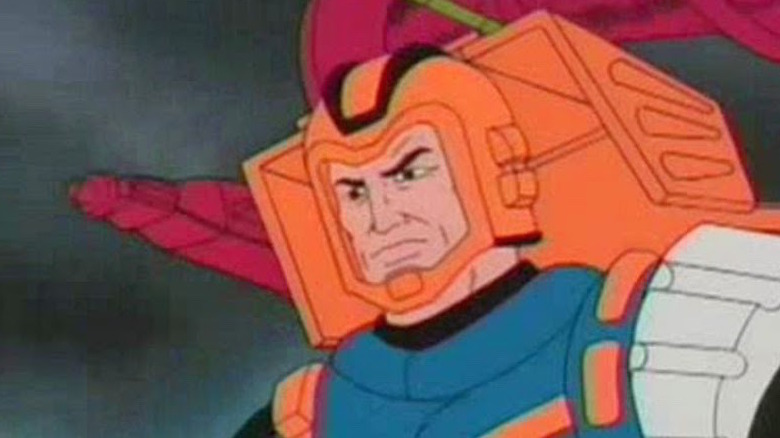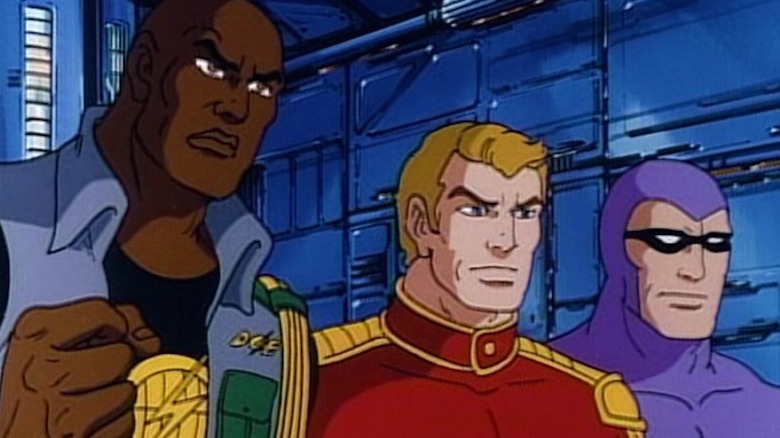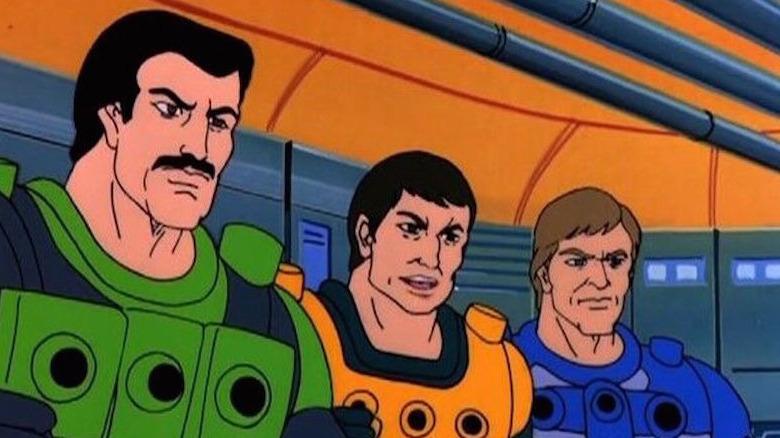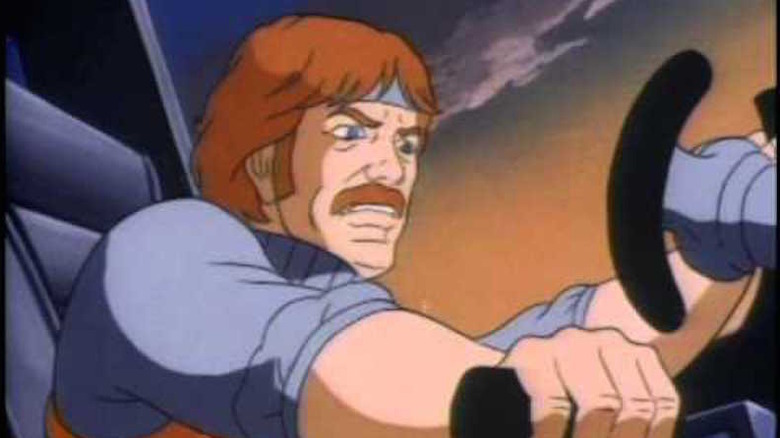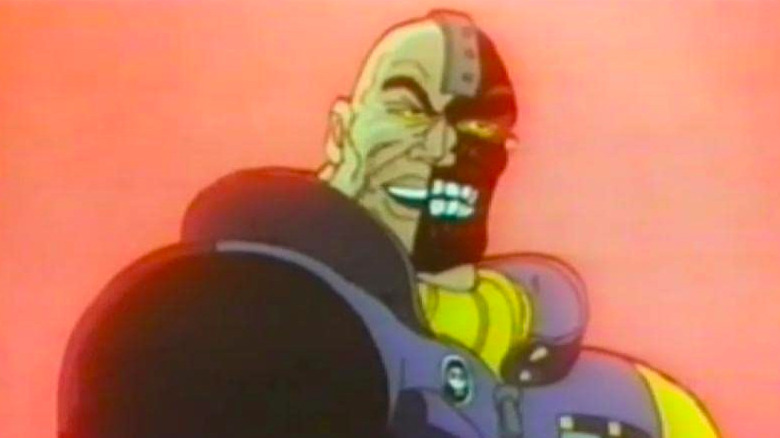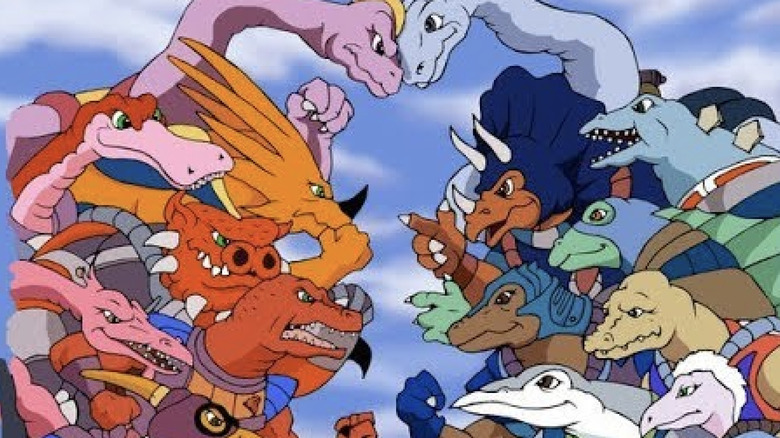The Weirdest G.I. Joe Ripoffs Ever
If imitation truly is the sincerest form of flattery, then the creators of the animated series "G.I. Joe: A Real American Hero" must have spent the '80s blushing from ear to ear. The series, produced by Marvel Productions, Sunbow Productions, and Hasbro, Inc., offered a simple baseline story — good guys vs. bad guys — which they spun into elaborate plotlines populated by every possible variation of soldier and spy imaginable. When you factor in the windfall of income the show enjoyed from Hasbro's vast line of toys — the inspiration for the series itself — and an endless array of related products and titles (including a live-action feature film series that is still treading water), you have a title any producer would covet.
For some animation companies in the 1980s, the next best thing to owning "G.I. Joe" was to make a show just like it. During and after the syndicated run of "Hero" between 1983 and 1986, Saturday mornings and after-school hours were overrun with cartoons depicting Joe/Cobra-like teams locked in combat, employing a dizzying array of weapons, vehicles, and other futuristic hardware — most available, of course, at a toy store near you.
However, savvy '80s kids knew a knockoff when they saw one, and most of these faux "Joe's" disappeared after a season (or less). Nonetheless, looking back decades later, some "Joe" ripoffs are remembered fondly, if only for earning a sort of infamy among animation fans for their bizarre plots and outlandish characters. Below, some of the strangest "G.I. Joe" knockoffs to lay siege to television sets during the decade of excess.
C.O.P.S. (1988 - 1989)
A joint effort between the French company DIC Entertainment Corporation and a Hasbro line of toys, "C.O.P.S." aired on CBS in 1988, offering a look at law enforcement in the then-distant future of 2020. Crime, it seems, is still a serious problem for metropolises like Empire City, where the Big Boss runs amuck and undeterred. Enter FBI agent Baldwin "Bulletproof" Vess, whose zeal for bringing down Big Boss is only slightly deterred when after he is paralyzed in a fight and outfitted with a robot torso.
Bulletproof assembles C.O.P.S. (Central Organization of Crime Specialists), a team of fellow gangbusters that includes Chicago cop Bowser and his K-9 sidekick Blitz, Texas Ranger Sundown, Boston officer A.P.E.S (and for some reason, a firefighter) to take on the forces of evil in Empire City. The Big Boss, not wanting to be left out of the team-building efforts, assembles C.R.O.O.K.S. (what that stands for is unclear), populating it with various outlandish types, including evil robots, a crooked old lady, and double crossers from Empire City's city council. Both also got a fun/ridiculous "Yo Joe!"-like battle cry ("It's crime fighting time!" for C.O.P.S. and "Crime's a-wasting!" for C.R.O.O.K.S.).
"C.O.P.S" actually had a connection to "G.I. Joe," through jittery military cop Checkpoint, whose Action File Card (the bio attached to his figure) alluded to the fact that his dad was "Joe" team member Beach Head. However, that tidbit wasn't enough to keep the show on the air beyond a single season and a 15-issue comic from DC.
Jayce and the Wheeled Warriors (1985 - 1986)
DIC also produced the French/Canadian sci-fi series "Jayce and the Wheeled Warriors." Based on the Mattel toy line, the series freely mixed tropes from "Star Wars," "Transformers," and "G.I. Joe." in a certifiably out-to-lunch premise: Futuristic teen Jayce and a very eccentric team (wizard, flower-girl hybrid, tiny robot knight, flying fish) battle the Saw Boss and his Monster Minds, an army of plant monsters created by Jayce's scientist father. Armed with a magic ring and magical root, Jayce and his pals use their tricked-out battalion of vehicles to search for his missing dad.
DIC produced 65 episodes of "Jayce," several of which were penned by veteran animation writers Larry DiTillio ("He- Man and She-Ra: Secret of the Sword") and J. Michael Straczynski ("Babylon 5," "Thor"), with whom DiTillio co-created "She-Ra: Princess of Power." However, the series ended without wrapping up its plotlines, leaving most "Jayce" fans to come up with their own conclusions using Mattel's sizable line of toys.
The Adventures of the Galaxy Rangers (1986)
TMS Entertainment, which later animated "The Real Ghostbusters" and "Batman: The Animated Series," oversaw this syndicated series created by Robert Mandell of "Princess Gwenevere and the Jewel Riders" fame. It imagined interstellar colonization as a sort of futuristic Manifest Destiny, complete with frontier towns and cowpoke types populating distant worlds.
Settlers of these new territories found themselves targeted by the Crown Empire and its villainous leader, the Queen of the Crown. To keep them and other alien heels in check, the Bureau for Extra-Terrestrial Affairs (BETA) had been formed; among their ranks is gunslinger Zachary Foxx (voiced by "Law & Order" actor Jerry Orbach) and his team (a tough sheriff, a psychic archaeologist, and a computer genius), each of whom is cybernetically enhanced with various powers to fight back against the Queen.
Cyborg space cowboys was certainly an unusual wrinkle for the fighting team concept, but to the credit of Mandell and his writers, the show's emphasis was divided equally between expansive storylines, character development, and shoot-em-up action — all set to a pair of block-rocking theme songs by composer John Van Tongeren and British hard rockers FM.
Lazer Tag Academy (1986)
Action figures weren't the only toys landing Saturday morning cartoons during the 1980s. Case in point: Lazer Tag, the infrared chase-and-shoot game from Worlds of Wonder, the company behind Teddy Ruxpin. Ruby-Spears developed the promotion-driven animated series "Lazer Tag Academy" in 1986, which bit off a chunk of "The Terminator" for its convoluted plotline.
"Lazer Tag Academy" also takes the rather ambitious position that the game will continue to dominate teenage toy buyers' attentions for another millennia. Case in point: hero Jamie Jaren, 13-year-old Lazer Tag champion of the year 3010, who can use the Starlyte (the game's "gun") to travel through time. She puts that ability to the test upon discovering that Draxon Drear, an arch criminal from the year 2061, has been awakened in the year 1987 in order to kill pre-teens Tom and Beth Jaren, who are Jamie's distant ancestors. Got all that?
Most viewers did not. "Lazer Tag Academy" ran for 13 episodes before Ruby-Spears plugged the plug; DIC tried their hand at a laser tag series that same year, though their production, "Photon" (based on the game of the same name) was a low-budget live-action series filmed partly in Japan. Viewers of "The Super Mario Bros. Super Show!" may recall being baffled by segments from "Photon," which was re-purposed on that series under the title "Spaced Out Theater."
M.A.S.K. (1985 - 1986)
Kenner's "M.A.S.K." line of transforming action vehicles inspired an eponymous DIC Enterprises series, which debuted in syndication in 1985. Both the toy line and the series borrowed heavily from the "G.I. Joe" and "Transformers" universes: here, the combatants locked in eternal struggle are the Mobile Armored Strike Kommand (M.A.S.K.), led by Matt Trakker (who in the toy line and comics, is a Tony Stark-styled billionaire philanthropist), and the hilariously-named Vicious Evil Network of Mayhem (V.E.N.O.M.) led by former M.A.S.K. chief Miles Mayhem. Both sides duked it out with a vast array of sidekicks, all sporting fun nicknames, and everyday vehicles that transformed into super-weapons. Just like Joe.
Though it lasted just 75 episodes, "M.A.S.K." has enjoyed a remarkable second life thanks to the marketing department at Hasbro, which purchased Kenner in 1991. In 2011,"M.A.S.K." was included as part of "Unit:E," a one-shot comic created for the 2011 New York Comic Con which brought together characters from many of its toy/cartoon/comic book franchises, including "G.I. Joe," "Micronauts," "Inhumanoids," "Action Man," and even "Stretch Armstrong." "M.A.S.K." also got its own comic title as part of IDW's Revolution imprint, which also crossed over with other Hasbro franchises like "ROM: Space Knight" and "Transformers." A live-action movie universe combining many of the Hasbro toy lines was announced in 2015.
Starcom: The U.S. Space Force
Like any great government idea, Space Force was originally conceived by '80s children's programming.
Created by Emmy-nominated writer Brynne Chandler ("Batman: The Animated Series") for DIC and distributed by Coca-Cola's television syndication wing, "Starcom: The U.S. Space Force" was, like "G.I. Joe" and so many other animated series, a DIC production inspired by a toy line. Coleco — makers of ColecoVision and the Cabbage Patch Kids — issued the Starcom line of outer space action figures, playsets, and vehicles in 1987, and released the "Starcom" series to help promote the toys. The premise was tried and true: American astronaut good guys (Starforce) vs. evil empire (Shadow Force), employing an impressive array of hardware including gunships, tanks, and various spacecraft.
Neither the series nor the toy line caught on with viewers, and the series disappeared after 13 episodes. Even the participation of the Young Astronauts' Council, which helped develop "Starcom" to promote interest in NASA, couldn't spark interest.
In possibly the strangest postscript one could imagine, in 2021 the real United States Space Force activated a field command called the "Space Training and Readiness Command" with the acronym — yup, STARCOM. Located at Vandenberg Space Force Base in California, one can only assume that the connection was unintentional — and hope that Shadow Force is not any sort of real-life imminent threat.
Visionaries: Knights of the Magical Light (1987)
Sunbow Productions, masterminds behind the "G.I. Joe" series (along with "My Little Pony," "Jem and the Holograms," and many other '80s classics), also created a series around Hasbro's "Visionaries: Knights of The Magical Light" line of action figures and toys. The series, which aired in syndication in 1987, bundled many of the popular action tropes: It was a team action series, set on the distant planet Prysmos, that also happened to feature magic.
The magical element came from a cosmic event that caused technology to fail on Prysmos, requiring its people to develop magical powers. Two teams of knights — the Visionaries (good guys) and Darkling Lords (bad guys, natch) — battled for powerful staffs and totems that allowed them to transform into animals. Some characters could also imbue their weapons or vehicles with magical powers.
Packaging on the toys and a tie-in comic series from Marvel's Star Comics imprint attempted to make sense of all these magical goings-on, but it wasn't easy. The series, toy line, and comic all ultimately collapsed in 1987, although in 2018 IDW revived the Visionaries for a five-issue comic miniseries that pitted them against the Transformers.
Rambo (1986)
The 1972 novel "First Blood" told the somber tale of a misunderstood Vietnam veteran coping with the then-nascent issue of battlefield-induced PTSD; Sylvester Stallone's 1982 film adaptation was a blood-soaked that brought the homeless, anguished drifter to life. Sounds like a great source for a kid's cartoon, huh?
Somehow, Stallone's violent, R-rated "Rambo" franchise made the jump to its own Ruby-Spears series (complete with "Rambo: The Force of Freedom" action figures) in 1986. The series side-stepped the most troubling issues — namely, Rambo's post-traumatic stress syndrome and his propensity for slaughtering opponents en masse — by making him part of a "Joe"-style team, the Force of Freedom, and reducing the body count to zero.
Col. Sam Trautman oversaw Rambo and his teammates: engineer/race car driver Turbo, master of disguise K.A.T., ninja White Dragon, ex-footballer Touchdown and a Native American saddled with the handle "Chief." Opposing them was the COBRA-esque group S.A.V.A.G.E., whose actual handle (Specialist-Administrators of Vengeance, Anarchy, and Global Extortion) made them sound like regional district business managers who moonlighted as terrorists. The amazingly-named General Warhawk (too on the nose?) led S.A.V.A.G.E's eccentric shock troops, which included the claw-handed Gripper, a biker gang (which featured a member named Jerkface) and White Dragon's brother, the aptly named Black Dragon. Clearly, whoever was naming these characters had a lot of fun.
"Rambo" generated a line of action figures and toys from Coleco, as well as book and tape sets, coloring books, and a slew of DVD releases. Toy company LJN had even put out a line of (soon to be banned) battery-powered water guns (and grenades and hunting knives) inspired by John Rambo's weaponry in "Rambo: First Blood Part II." None of this, however, generated a positive response from Sylvester Stallone — who expressed displeasure (and an overall helplessness) that his trigger-happy franchise was being neutered and marketed to kids.
In a 1986 interview with the Chicago Tribune, Stallone explained of the show, which was voiced by an impersonator named Neil Ross: "'It's not for kids. The movie was not supposed to be for little kids, and I wouldn't let my own children play with those toys ... First of all, that isn't Rambo. But, more important, they tell me I can't stop them because it's not me they are using; it's a likeness of a character I played and don't own.”
Sky Commanders (1987)
Hanna-Barbera waded into the action team/toy tie-in fray with the 1987 series "Sky Commanders." Produced as part of their syndicated programming block "The Funtastic World of Hanna-Barbera," and based on a line of action figures from Kenner Toys, "Sky Commanders" pitted the titular heroes, led by the awesomely named General Mike Summit, against the equally cool-sounding General Lucas Plague and his Raiders. Though most action team series identified their members by their abilities, the Sky Commanders were distinguished by their countries of origin, which included Australia, Jamaica, Ireland, Canada, and one member of the Inuit tribe.
The two teams battled over a new continent, the High Frontier, which emerged in the South Pacific following the release of a radioactive element called Phaeta-7. Standing in the way of either team's success were dangers inherent to the High Frontier, including hurricanes, lava, and various monsters. Despite an impressive voice cast led by Robert Ridgley ("Boogie Nights") as Mike Summit and featuring, among others, William Windom, Dorian Harewood, and "Love Boat" alum Lauren Tewes in the supporting cast, "Sky Commanders" lasted just 13 episodes.
Defenders of the Earth (1986 - 1991)
Marvel Productions teamed with the print syndication company King Features to bring several of their longest-running comic book heroes to television in a series that lasted longer than most of the other "Joe" rip-offs on this list. The result was "Defenders of the Earth," which united three major comic strip heroes from the 1930s — Flash Gordon, the Phantom, and Mandrake the Magician (along with his assistant, Lothar) — to battle Flash's old nemesis, Ming the Merciless. Aiding the Defenders in their battle was none other than the quartet's own kids: Flash and Dale Arden's son, Rick; Jedda Walker, daughter of the Phantom; Lother's martial arts-adept son, L.J.; and Kshin, the adopted son and apprentice to Mandrake.
Given that, in their original incarnations, Flash, Mandrake, and the Phantom were essentially normal humans who battled evil with pure American gumption and can-do spirit, Marvel wisely supercharged them. Mandrake could now actually create spells (in the comics, he was simply skilled at sleight-of-hand), the Phantom had the power of "ten tigers," and Lothar was front-loaded with tactical and fighting skills. Flash, to his credit, remained his badass, ex-football-hero self.
Marvel produced 65 episodes of "Defenders of the Earth," and released a comic book tie-in on their Star Comics imprint; the first issue featured a story credit by Stan Lee, but the title only lasted four issues. Galoob produced several action figures, while Enigma Variations Software created a video game based on the series.
Centurions
A trio of comic book and animation legends collaborated on Ruby-Spears' syndicated series "The Centurions." Designs and concepts for the sci-fi/adventure program were created by none other than Marvel/DC titan Jack Kirby, along with Gil Kane (who gave us the modern-day Green Lantern and co-created Iron Fist) and Doug Wildey (who created "Jonny Quest"). A host of big-name science fiction and animation writers also penned scripts, including Larry DiTillo, Marc Scott Zicree, and Michael Reaves.
However, an impressive pedigree such as the one sported by "The Centurions" did not translate into an equally memorable program. The series, composed of 65 episodes that aired in 1986, was a standard issue good team/bad team face-off, with the Centurions — a quintet of manly heroes in powerful exo-suits — pitted against cyborg mad scientist Doc Terror and his robot army. Two animal sidekicks, a dog with a rocket launcher in his collar and an orangutan, also factored into the story.
Kenner issued a number of tie-in toys (including action figures and play sets) while DC released a short-lived, four-issue comic series. The series would later be re-run on the Cartoon Network.
Chuck Norris: Karate Kommandos
"The Centurions" wasn't the only '80s cartoon to employ Jack Kirby's talents, and "Rambo" wasn't the only '80s to take an adult action hero and try to turn him into an action figure. Toy and cartoons were all part of the launch of "Karate Kommandos," a high profile Ruby-Spears action series that attempted to turn Chuck Norris into an animated hero.
Norris, who created the syndicated series, also voiced his animated likeness, which was partnered with an oddball crew to battle the evil Claw (whose right arm was a metal claw, natch) and his ninja minions. Assisting Chuck was a tech expert, her teen brother, Chuck's young Filipino ward, and (for reasons perhaps known only to Chuck Norris) a sumo wrestler. Norris also appeared in live-action form to introduce each episode and deliver a tidy moral at the conclusion (further ripping off the GI Joe "knowing is half the battle" segments). Kenner and Star Comics issued the obligatory action figure and 1987 comic series, respectively.
Shockingly, the idea of Chuck Norris battling for our safety and freedom while accompanied by a constantly hungry sumo wrestler and two goofy teens did not catch the attention of cartoon viewers in 1986. "Karate Kommados" was TKOd after only five episodes.
Ring Raiders (1989)
Matchbox, the toy company behind Hot Wheels, expanded their efforts into miniature planes with the "Ring Raiders" series. The toys were tiny jet fighters attached via a movable base to a ring kids would wear in order to act out its team action plotline of good guy Ring Raiders vs. the bad guys, Skull Squadron.
Sounds like a tough launching pad for a TV series, doesn't it? For producers DIC and Bohbot Communications (which distributed the "Adventures of Sonic the Hedgehog" series, among others), however, a toy plane stuck on a ring did not present any dramatic roadblocks, and in 1989, "Ring Raiders" debuted on syndication in a two-hour special.
The producers' solution to the stuck-plane problem was to turn the Skull Squadron into a COBRA-styled organization with designs on world domination. In the not-too-distant future (the futuristic 1998), the Squadron had grown large enough to make good on those plans. The world's armies had responded by creating the Ring Raiders, an elite fighter squad whose planes could travel through time. The Raiders used that ability to snatch up the greatest pilots in history, employing them in the fight against the Skull Squadron.
Oh, and the ring part? The Raider leaders, known as "Ring Commanders," each had a special ring that could summon other Ring Raiders when needed. A comic book series, released by Fleetway Publications, attempted to clarify all the details — but by that point, it was far too late for the Ring Raiders; the series was axed after only five episodes.
Dinosaucers (1987)
Michael E. Uslan, who has produced all the live-action and animated "Batman" films since Tim Burton's "Batman" in 1989, also produced this offbeat U.S.-Canadian series for DIC in 1987. The premise of "Dinosaucers" took the "G.I. Joe" format and folded in anthropomorphic dinosaurs who arrived via UFO from a planet orbiting Earth. Because, well, why not?
Though the Tyrannos (the show's COBRA stand-ins) had the saurian firepower in the form of their leader, Genghis Rex, the show's good guys, the Dinosaucers, had an ace up their scaly sleeves. When a button was pressed on their uniforms, the Dinosaucers transformed from two-legged dinos to their original, four-legged, king-sized forms (but would maintain their evolved intelligence and ability to speak). Aiding the Dinosaucers was a quartet of human teens, the Secret Scouts, who wielded their own special powers courtesy of magic rings. Apparently, rings were a big thing back in the '80s.
Sixty-five episodes of "Dinosaucers" were produced before DIC and series distributors Coca-Cola Telecommunications rendered the dino show extinct. However, Uslan briefly revived the property in 2018 for a five-part comic series from Lion Forge. He's also reportedly attempting to get a feature film off the ground.
